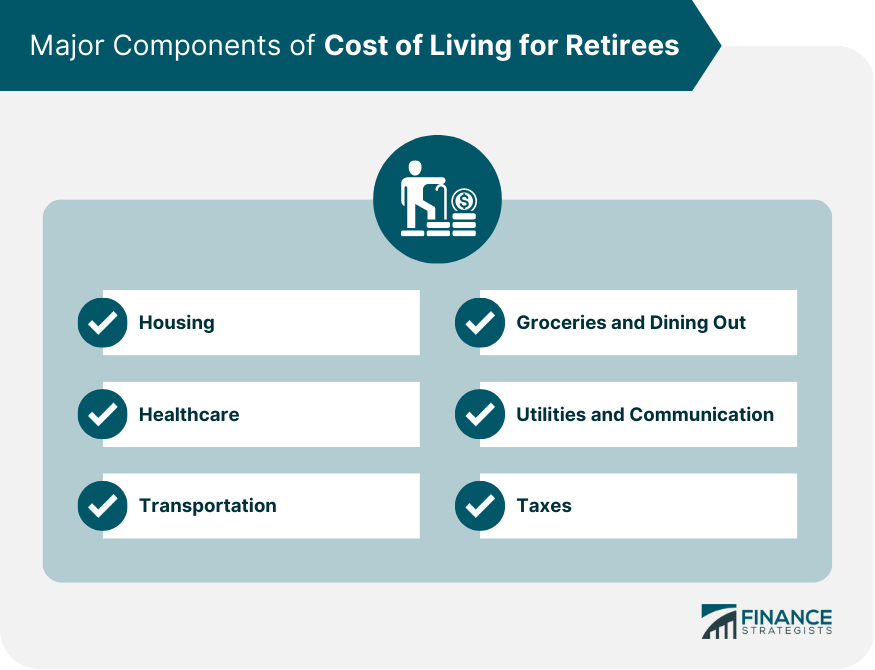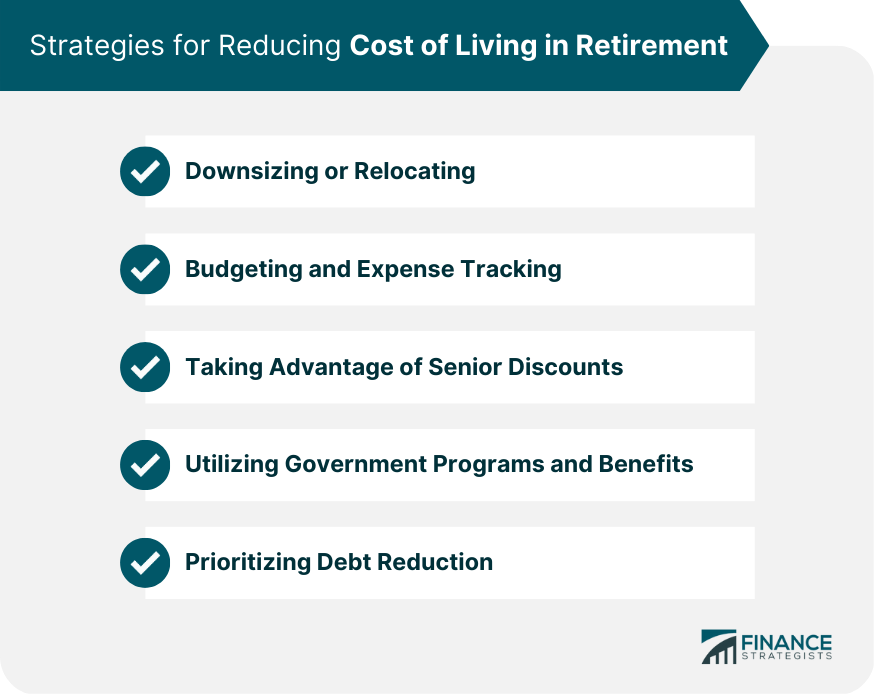Cost of living refers to the amount of money required to maintain a certain standard of living in a specific location, taking into account expenses such as housing, food, transportation, and healthcare. Understanding and managing the cost of living in retirement is essential for financial security and maintaining one's desired lifestyle. Proper planning can help retirees make informed decisions about where to live, how to budget, and how to allocate their resources effectively. Housing is often the largest expense for retirees, whether they rent or have a mortgage to pay off. Retirees who own their homes must also consider property taxes, which can vary significantly depending on the location. Insurance costs, including homeowners or renters insurance, contribute to the overall expenses in retirement. Ongoing maintenance and repairs are essential for maintaining a home, and these costs should be factored into a retiree's budget. Retirees typically rely on Medicare for health insurance, but premiums, deductibles, and copays can still add up. Some retirees may choose to purchase supplemental insurance to cover costs not covered by Medicare. Retirees should budget for out-of-pocket healthcare expenses, such as prescription medications and dental care. Long-term care, such as assisted living or nursing home care, can be a significant expense for retirees and should be considered when planning for retirement. Owning a vehicle can be costly, with expenses including insurance, maintenance, fuel, and registration fees. Public transportation can be a more affordable option for retirees, especially in urban areas with well-developed transit systems. Retirees may wish to budget for travel expenses, whether for leisure or to visit family and friends. Food costs, including groceries and dining out, are an important component of a retiree's cost of living. Utilities such as electricity, gas, and water contribute to a retiree's overall cost of living. Communication services, including phone, internet, and cable, are essential for staying connected and informed. Retirees must consider income taxes on retirement account withdrawals, Social Security benefits, and other sources of income. Sales taxes can vary by state and can impact a retiree's overall cost of living. As mentioned earlier, property taxes can be a significant expense for retirees who own their homes. The cost of living in the United States varies greatly by region, with some areas being significantly more expensive than others. Here are some geographical differences in the cost of living in the US: The East Coast, especially major cities like New York and Boston, is known for having a high cost of living. Housing is a major expense, with rent and real estate prices among the highest in the country. Taxes and the cost of goods and services are also high. The West Coast, including California, Oregon, and Washington, is also known for having a high cost of living. Housing is again a major expense, with cities like San Francisco and Los Angeles having some of the highest real estate prices in the country. The cost of goods and services is also generally high. The South is generally known for having a lower cost of living than the coasts. Housing is often more affordable, with cities like Houston and Atlanta offering lower real estate prices than major coastal cities. The cost of goods and services is also generally lower. The Midwest region of the US is generally known for having a lower cost of living than the coasts. Housing is often more affordable, with cities like Chicago and Minneapolis having lower real estate prices than many coastal cities. The cost of goods and services is also generally lower. Rural areas throughout the US are often more affordable than urban areas. Housing is generally more affordable, and the cost of goods and services is often lower due to less demand. Downsizing to a smaller home or relocating to a more affordable area can significantly reduce a retiree's cost of living, freeing up resources for other expenses or savings. Creating and maintaining a budget can help retirees monitor their expenses and make adjustments as needed to control their cost of living. Many businesses and organizations offer senior discounts, which can help retirees save on a variety of goods and services. Retirees may be eligible for various government programs and benefits, such as property tax relief, energy assistance, and prescription drug assistance, which can help reduce their cost of living. Reducing or eliminating debt before retirement can help lower a retiree's cost of living, as they will have fewer obligations to meet each month. Inflation can erode the purchasing power of retirement savings over time, making it essential for retirees to plan for cost of living increases. Social Security benefits are subject to annual cost of living adjustments (COLAs) based on the Consumer Price Index for Urban Wage Earners and Clerical Workers (CPI-W). These adjustments help protect the purchasing power of Social Security benefits. Retirees may need to adjust their retirement income strategies to account for inflation and cost of living increases, such as by increasing withdrawals from savings or adjusting their investment portfolios. When creating a retirement budget, retirees should consider all sources of income, including Social Security benefits, pension income, retirement account withdrawals, and any part-time work or passive income. A comprehensive retirement budget should account for all major expenses, including housing, healthcare, transportation, groceries, utilities, taxes, and discretionary spending. Retirees should also include an emergency fund in their budget to cover unexpected expenses, such as medical emergencies or major home repairs. As a retiree's circumstances change, their budget should be regularly reviewed and adjusted to ensure it remains aligned with their income, expenses, and goals. Understanding and managing the cost of living in retirement is crucial for financial security and maintaining one's desired lifestyle. By considering the various factors that impact the cost of living, retirees can make informed decisions about where to live, how to budget, and how to allocate their resources effectively. Employing strategies such as downsizing or relocating, budgeting and expense tracking, and planning for inflation and cost of living adjustments can help retirees manage their cost of living and achieve greater financial security during their golden years.Cost of Living for Retirees: Overview
Major Components of Cost of Living for Retirees
Housing
Rent or Mortgage
Property Taxes
Homeowners or Renters Insurance
Maintenance and Repairs
Healthcare
Medicare Premiums
Supplemental Insurance
Out-Of-Pocket Expenses
Long-Term Care Costs
Transportation
Vehicle Ownership
Public Transportation
Travel
Groceries and Dining Out
Utilities and Communication
Electricity, Gas, and Water
Phone, Internet, and Cable Services
Taxes
Income Taxes
Sales Taxes
Property Taxes

Geographical Differences in Cost of Living
East Coast
West Coast
South
Midwest
Rural Areas
Strategies for Reducing Cost of Living in Retirement
Downsizing or Relocating
Budgeting and Expense Tracking
Taking Advantage of Senior Discounts
Utilizing Government Programs and Benefits
Prioritizing Debt Reduction

Planning for Inflation and Cost of Living Adjustments (COLAs)
The Impact of Inflation on Retirement Savings
Social Security COLAs
Adjusting Retirement Income Strategies
Creating a Comprehensive Retirement Budget
Assessing Income Sources
Evaluating Expenses
Planning for Emergencies and Unexpected Costs
Adjusting Budget Over Time
Conclusion
Cost of Living for Retirees FAQs
The cost of living for retirees refers to the amount of money needed to cover basic living expenses, such as housing, food, healthcare, and transportation, during retirement.
Retirees can manage the cost of living during retirement by creating a budget, reducing expenses, maximizing retirement income sources, and considering lifestyle changes that can reduce costs, such as downsizing to a smaller home or moving to a more affordable area.
Social Security benefits can impact the cost of living for retirees, as the cost of living adjustment (COLA) is a yearly increase in Social Security benefits that is intended to keep pace with inflation and rising costs. However, the COLA is not always sufficient to cover all of the cost increases that retirees may experience.
Retirees can plan for unexpected expenses during retirement by building an emergency fund, exploring options for long-term care insurance, and working with a financial advisor to create a retirement plan that includes contingencies for unexpected expenses.
Retirees can manage taxes in retirement by taking advantage of tax-advantaged retirement accounts, considering strategies for reducing taxable income, and working with a tax professional to create a tax-efficient retirement plan.
True Tamplin is a published author, public speaker, CEO of UpDigital, and founder of Finance Strategists.
True is a Certified Educator in Personal Finance (CEPF®), author of The Handy Financial Ratios Guide, a member of the Society for Advancing Business Editing and Writing, contributes to his financial education site, Finance Strategists, and has spoken to various financial communities such as the CFA Institute, as well as university students like his Alma mater, Biola University, where he received a bachelor of science in business and data analytics.
To learn more about True, visit his personal website or view his author profiles on Amazon, Nasdaq and Forbes.











